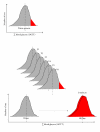Early-life origins of type 2 diabetes: fetal programming of the beta-cell mass
- PMID: 22110471
- PMCID: PMC3202114
- DOI: 10.1155/2011/105076
Early-life origins of type 2 diabetes: fetal programming of the beta-cell mass
Abstract
A substantial body of evidence suggests that an abnormal intrauterine milieu elicited by maternal metabolic disturbances as diverse as undernutrition, placental insufficiency, diabetes or obesity, may program susceptibility in the fetus to later develop chronic degenerative diseases, such as obesity, hypertension, cardiovascular diseases and diabetes. This paper examines the developmental programming of glucose intolerance/diabetes by disturbed intrauterine metabolic condition experimentally obtained in various rodent models of maternal protein restriction, caloric restriction, overnutrition or diabetes, with a focus on the alteration of the developing beta-cell mass. In most of the cases, whatever the type of initial maternal metabolic stress, the beta-cell adaptive growth which normally occurs during gestation, does not take place in the pregnant offspring and this results in the development of gestational diabetes. Therefore gestational diabetes turns to be the ultimate insult targeting the offspring beta-cell mass and propagates diabetes risk to the next generation again. The aetiology and the transmission of spontaneous diabetes as encountered in the GK/Par rat model of type 2 diabetes, are discussed in such a perspective. This review also discusses the non-genomic mechanisms involved in the installation of the programmed effect as well as in its intergenerational transmission.
Figures



Similar articles
-
Maternal diabetes, programming of beta-cell disorders and intergenerational risk of type 2 diabetes.Diabetes Metab. 2014 Nov;40(5):323-30. doi: 10.1016/j.diabet.2014.02.003. Epub 2014 Jun 16. Diabetes Metab. 2014. PMID: 24948417 Review.
-
Programming of the endocrine pancreas by the early nutritional environment.Int J Biochem Cell Biol. 2006;38(5-6):913-22. doi: 10.1016/j.biocel.2005.10.012. Epub 2005 Nov 10. Int J Biochem Cell Biol. 2006. PMID: 16337425 Review.
-
A euglycaemic/non-diabetic perinatal environment does not alleviate early beta cell maldevelopment and type 2 diabetes risk in the GK/Par rat model.Diabetologia. 2013 Jan;56(1):194-203. doi: 10.1007/s00125-012-2733-8. Epub 2012 Oct 12. Diabetologia. 2013. PMID: 23064288
-
Diabetes-induced perturbations are subject to intergenerational transmission through maternal line.J Physiol Biochem. 2016 Jun;72(2):315-26. doi: 10.1007/s13105-016-0483-7. Epub 2016 Apr 2. J Physiol Biochem. 2016. PMID: 27038466
-
Fetal determinants of type 2 diabetes.Curr Drug Targets. 2007 Aug;8(8):935-41. doi: 10.2174/138945007781386866. Curr Drug Targets. 2007. PMID: 17691930 Review.
Cited by
-
Maternal obesity and overnutrition increase oxidative stress in male rat offspring reproductive system and decrease fertility.Int J Obes (Lond). 2015 Apr;39(4):549-56. doi: 10.1038/ijo.2014.209. Epub 2014 Dec 15. Int J Obes (Lond). 2015. PMID: 25504042
-
Obesity in prematurely born children and adolescents: follow up in pediatric clinic.Nutr J. 2013 Nov 19;12(1):150. doi: 10.1186/1475-2891-12-150. Nutr J. 2013. PMID: 24252330 Free PMC article.
-
Streptozotocin-induced diabetes models: pathophysiological mechanisms and fetal outcomes.Biomed Res Int. 2014;2014:819065. doi: 10.1155/2014/819065. Epub 2014 May 27. Biomed Res Int. 2014. PMID: 24977161 Free PMC article. Review.
-
Design, implementation, and evaluation of a pediatric and adolescent type 2 diabetes management program at a tertiary pediatric center.J Multidiscip Healthc. 2014 Jul 31;7:321-31. doi: 10.2147/JMDH.S63842. eCollection 2014. J Multidiscip Healthc. 2014. PMID: 25114539 Free PMC article.
-
Effects on metabolic parameters in young rats born with low birth weight after exposure to a mixture of pesticides.Sci Rep. 2018 Jan 10;8(1):305. doi: 10.1038/s41598-017-18626-x. Sci Rep. 2018. PMID: 29321614 Free PMC article.
References
-
- Harris MI, Klein R, Welborn TA, Knuiman MW. Onset of NIDDM occurs at least 4–7 yr before clinical diagnosis. Diabetes Care. 1992;15(7):815–819. - PubMed
-
- Butler AE, Janson J, Bonner-Weir S, Ritzel R, Rizza RA, Butler PC. β-cell deficit and increased β-cell apoptosis in humans with type 2 diabetes. Diabetes. 2003;52(1):102–110. - PubMed
-
- Florez JC. Newly identified loci highlight β-cell dysfunction as a key cause of type 2 diabetes: where are the insulin resistance genes? Diabetologia. 2008;51(7):1100–1110. - PubMed
-
- Saenger P, Czernichow P, Hughes I, Reiter EO. Small for gestational age: short stature and beyond. Endocrine Reviews. 2007;28(2):219–251. - PubMed
Publication types
MeSH terms
LinkOut - more resources
Full Text Sources
Other Literature Sources
Medical
